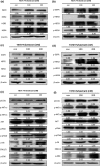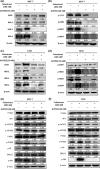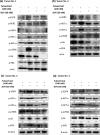HSP90 inhibitor AUY922 can reverse Fulvestrant induced feedback reaction in human breast cancer cells
- PMID: 28301080
- PMCID: PMC5480065
- DOI: 10.1111/cas.13238
HSP90 inhibitor AUY922 can reverse Fulvestrant induced feedback reaction in human breast cancer cells
Abstract
Hormone therapy has become one of the main strategies for breast cancer, however, many estrogen receptor (ER) positive patients end in tumor collapse due to initial or acquired resistance to hormone treatment, which includes Fulvestrant. Here we report that ErbB receptors and downstream PI3K/AKT and ERK pathway have been reactivated after treatment of Fulvestrant in ER positive MCF-7 and T47D cells, which are related to Fulvestrant resistance. HSP90 is a universally expressed chaperone protein and plays a vital role in both normal and cancer cells, HSP90 inhibitor AUY922 can reverse this feedback reactivation effect of Fulvestrant by targeting multiple proteins related in ErbB receptors, PI3K/AKT and ERK pathway, which is much better than single targeting inhibitors. We also consolidate these effects in human fresh breast tumors. Combination of AUY922 and Fulvestrant may become a promising therapy strategy in breast cancer treatment.
Keywords: AUY922; ErbB receptors; PI3K/AKT; fulvestrant; hormone resistance.
© 2017 The Authors. Cancer Science published by John Wiley & Sons Australia, Ltd on behalf of Japanese Cancer Association.
Figures






Similar articles
-
AKT Antagonist AZD5363 Influences Estrogen Receptor Function in Endocrine-Resistant Breast Cancer and Synergizes with Fulvestrant (ICI182780) In Vivo.Mol Cancer Ther. 2015 Sep;14(9):2035-48. doi: 10.1158/1535-7163.MCT-15-0143. Epub 2015 Jun 26. Mol Cancer Ther. 2015. PMID: 26116361
-
HSP90 inhibitor AUY922 abrogates up-regulation of RTKs by mTOR inhibitor AZD8055 and potentiates its antiproliferative activity in human breast cancer.Int J Cancer. 2014 Nov 15;135(10):2462-74. doi: 10.1002/ijc.28880. Epub 2014 Apr 17. Int J Cancer. 2014. PMID: 24706460
-
Overcoming endocrine resistance due to reduced PTEN levels in estrogen receptor-positive breast cancer by co-targeting mammalian target of rapamycin, protein kinase B, or mitogen-activated protein kinase kinase.Breast Cancer Res. 2014 Sep 11;16(5):430. doi: 10.1186/s13058-014-0430-x. Breast Cancer Res. 2014. PMID: 25212826 Free PMC article.
-
Endocrine therapy and strategies to overcome therapeutic resistance in breast cancer.Curr Probl Cancer. 2016 Mar-Aug;40(2-4):95-105. doi: 10.1016/j.currproblcancer.2016.09.001. Epub 2016 Sep 17. Curr Probl Cancer. 2016. PMID: 27839747 Review.
-
The immunomodulatory effects of endocrine therapy in breast cancer.J Exp Clin Cancer Res. 2021 Jan 7;40(1):19. doi: 10.1186/s13046-020-01788-4. J Exp Clin Cancer Res. 2021. PMID: 33413549 Free PMC article. Review.
Cited by
-
EB1089 Increases the Antiproliferative Response of Lapatinib in Combination with Antiestrogens in HER2-Positive Breast Cancer Cells.Int J Mol Sci. 2024 Mar 9;25(6):3165. doi: 10.3390/ijms25063165. Int J Mol Sci. 2024. PMID: 38542136 Free PMC article.
-
Targeting Heat-Shock Protein 90 in Cancer: An Update on Combination Therapy.Cells. 2022 Aug 17;11(16):2556. doi: 10.3390/cells11162556. Cells. 2022. PMID: 36010632 Free PMC article. Review.
-
Potential benefits of combined treatment with Hsp90 inhibitor AUY922 and cisplatin for overcoming drug resistance in nasopharyngeal carcinoma.Am J Cancer Res. 2025 Feb 15;15(2):533-545. doi: 10.62347/OSGO7209. eCollection 2025. Am J Cancer Res. 2025. PMID: 40084353 Free PMC article.
-
Cancer drug resistance: rationale for drug delivery systems and targeted inhibition of HSP90 family proteins.Cancer Drug Resist. 2019 Sep 19;2(3):381-398. doi: 10.20517/cdr.2019.26. eCollection 2019. Cancer Drug Resist. 2019. PMID: 35582577 Free PMC article. Review.
-
Heat Shock Proteins: Agents of Cancer Development and Therapeutic Targets in Anti-Cancer Therapy.Cells. 2019 Dec 24;9(1):60. doi: 10.3390/cells9010060. Cells. 2019. PMID: 31878360 Free PMC article. Review.
References
-
- Cuzick J, Sestak I, Baum M et al Effect of anastrozole and tamoxifen as adjuvant treatment for early‐stage breast cancer: 10‐year analysis of the ATAC trial. Lancet Oncol 2010; 11: 1135–41. - PubMed
-
- Thrane S, Pedersen AM, Thomsen MB et al A kinase inhibitor screen identifies Mcl‐1 and Aurora kinase A as novel treatment targets in antiestrogen‐resistant breast cancer cells. Oncogene 2015; 34: 4199–210. - PubMed
-
- Sommer A, Hoffmann J, Lichtner RB, Schneider MR, Parczyk K. Studies on the development of resistance to the pure antiestrogen Faslodex in three human breast cancer cell lines. J Steroid Biochem Mol Biol 2003; 85 (1): 33–47. - PubMed
MeSH terms
Substances
LinkOut - more resources
Full Text Sources
Other Literature Sources
Medical
Research Materials
Miscellaneous

